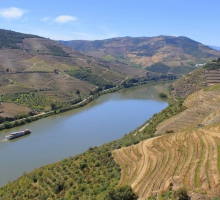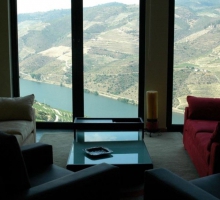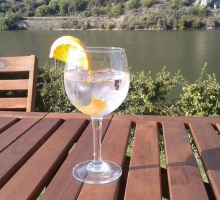The Douro River begins in Spain, more precisely in Urbión Mountain. It is the second largest river in Portugal with a total length of 927 Km; in the Portuguese territory, it is only 210 km long and is navigable all along that course thanks to the 5 dams allowing navigation.
Travellers can enjoy unparalleled landscapes along its entire length, for example the Alto Douro Vinhateiro, in which the municipality of Tabuaço is located, which was listed as World Heritage by UNESCO in 2001.
The Douro is not only a river or a region. It’s much more as it entails its history and the people who make it so special. It is not only about visiting this region, but also about exploring a unique place filled with stories, culture, unique people, and magnificent natural landscapes in perfect union with the toil of men over the years, offering us unique feelings and sensations.
Once narrow and dangerous, this river has brought prosperity to the region, being used to transport the casks filled with the precious nectar: Port wine. In former times, it was a great challenge to those who sailed on it. It was filled with half submerged rocks and its currents were very strong. Back then, only the small wooden boats (the Rebelo boats) challenged the river to carry the wine downstream from the Douro valley to the mouth of the river, flanked by the cities of Porto and Vila Nova de Gaia and its wine cellars.
There are several explanations for the origin of the name “Douro”. One legend has it that it was common to see some small, shiny rolling stones, that turned out to be gold, while others believe that the name comes from the clay-like colour of the river waters. Others believe that the name comes from the Latin word “Durius”, that is, “Duro” (hard), due to the harshness of its winding course formed by high rocky cliffs.
Location: Tabuaço
Travellers can enjoy unparalleled landscapes along its entire length, for example the Alto Douro Vinhateiro, in which the municipality of Tabuaço is located, which was listed as World Heritage by UNESCO in 2001.
The Douro is not only a river or a region. It’s much more as it entails its history and the people who make it so special. It is not only about visiting this region, but also about exploring a unique place filled with stories, culture, unique people, and magnificent natural landscapes in perfect union with the toil of men over the years, offering us unique feelings and sensations.
Once narrow and dangerous, this river has brought prosperity to the region, being used to transport the casks filled with the precious nectar: Port wine. In former times, it was a great challenge to those who sailed on it. It was filled with half submerged rocks and its currents were very strong. Back then, only the small wooden boats (the Rebelo boats) challenged the river to carry the wine downstream from the Douro valley to the mouth of the river, flanked by the cities of Porto and Vila Nova de Gaia and its wine cellars.
There are several explanations for the origin of the name “Douro”. One legend has it that it was common to see some small, shiny rolling stones, that turned out to be gold, while others believe that the name comes from the clay-like colour of the river waters. Others believe that the name comes from the Latin word “Durius”, that is, “Duro” (hard), due to the harshness of its winding course formed by high rocky cliffs.
Location: Tabuaço








